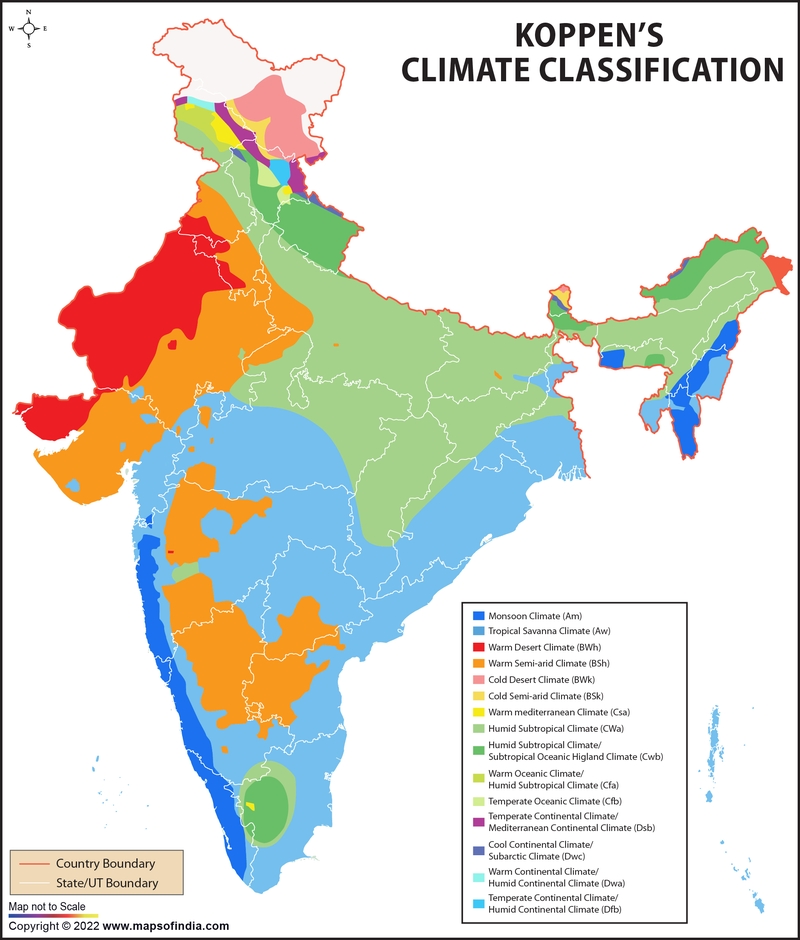India’s climate is generally called as ‘Monsoon’ type. However, the climatic conditions vary from region to region because of various factors like Latitude, the Himalayan Mountains, Distribution of land and water, Distance from the Sea, Altitude, Relief, Surface pressure and winds, Jet stream and upper air circulation, and Western cyclonic disturbances and tropical cyclones.
To better understand the change in climate by classifying it based on different parameters, broadly three approaches are used:
- Empirical Classification: It is based on observed data on temperature and precipitation.
- Genetic Classifications: It tries to classify climates according to their causes.
- Applied Classification: It classifies climate for a specific purpose.
One such type of empirical classification is Koeppen’s Climate Classifications.
Koeppen’s Climate Classifications
Koeppen’s Climate Classification is the most widely used in India. It was developed by V. Koeppen in 1918. He further refined and modified it and the final version of the classification came in 1936. He was a great German Climatologist and an amateur Botanist.
He studied in detail the relationship between the distribution of vegetation and climate before coming up with his classifications. After selecting some values of temperature and precipitation he tried to relate them to the distribution of vegetation and then used these values to classify climates.
According to these classifications, he divided the climate into five different groups and denoted them with capital letters- A, B, C, D, E, and H. These groups further have small sub-sections that are denoted with small letters. Here ‘f’ means no dry season, ‘m’ means monsoon climate, ‘w’ means winter dry season, and ‘s’ means summer dry season. The small letters a, b, c, and d denote the degree of severity of temperature.
Climatic Groups According to Koeppen
| Group | Characteristics |
|---|---|
| A - Tropical | The average temperature of the coldest month is 18° C or higher |
| B - Dry Climates | Potential evaporation exceeds precipitation |
| C - Warm Temperature | The average temperature of the coldest month of the (Mid-latitude) climates years is higher than minus 3°C but below 18°C |
| D - Cold Snow Forest Climates | The average temperature of the coldest month is minus 3° C or below |
| E - Cold Climates | Cold Climates Average temperature for all months is below 10° C |
| H - Highlands | Cold due to elevation |
Climatic Types According to Koeppen
| Group | Type | Letter Code | Characteristics |
|---|---|---|---|
| A - Tropical Humid Climate | Tropical Wet | Af | No dry season |
| Tropical Monsoon | Am | Monsoonal, Short dry season | |
| Tropical wet and dry | Aw | Winter dry season | |
| B - Dry Climate | Subtropical Steppe | BSh | Low-latitude semi-arid or dry |
| Subtropical Desert | BWh | Low-latitude arid | |
| Mid-latitude Steppe | BSk | Mid-latitude semi-arid or dry | |
| Mid-latitude Desert | BWk | Mid-latitude arid or dry | |
| C - Warm temperate Climates | Humid subtropical | Cfa | No dry season |
| Mediterranean | Cs | Dry hot summer | |
| Marine west coast | Cfb | No dry season, warm and cool summer | |
| D - Cold Snow-forest Climates | Humid Continental Subarctic | Df | No dry season, severe winter |
| Dw | Winter dry and very severe | ||
| E - Cold climates | Tundra | ET | No true summer |
| Polar ice cap | EF | Perennial ice | |
| H - Highland | Highland | H | Highland with snow cover |
Criticism of Koeppen’s Climate Classifications
The classifications given by Koeppen were widely accepted but it is also criticized on several factors. It is being said that is based only on the averages while extreme conditions like periodic drought or an unusual cold spell also affect the vegetation distribution of an area. The concept of this classification is very vast which might become a problem in memorizing it.
Another reason for which it is criticized is that it does not take all the factors consideration that affects the climate. The intensity of the precipitation, number of rainy days, cloud coverage, and variations in temperature or precipitation are some of the factors that were ignored by Koeppen while defining his classifications.
- National Science Museums in India
- Jyotirlinga Shrines
- Geological Map of India
- Canals in India
- Major Lakes in India
- Heritage Map of India
- Pin Code Zones in India
- Per Capita Income of India
- Major Sea Ports
- Languages in India
- Climate map of India
- Parlimentary Constituencies in India
- Tourist Circuits in India
- Metallic Minerals in India
- Cold Desert Map
- Major Electricity Generator Plants
- Religions In India
- Major Earthquakes in India
- Major Hydro Power Plants
- Indian States and Union Territories
- Cabinet Ministers
- Map of Indian States and Union Territories Enlarged View
- Physiographic Map of India
- Religious Places in India
- Geographical Map of India
- Dams in India
- India Coal Reserves Map
- India Political Map Enlarged View
- India Satellite Map
- Topographic Map of India
- Population Map Of India
- Natural Hazard Map of India
- Tourist Map of India Enlarged View
- Tier I and Tier II Cities of India
- Cyclone Prone Areas in India
- Outline Map of India Enlarged View
- Wine Producing Regions in India
- Map of Major Airports in India
- Birth Rate in India
- Statehood Movements in India
Last Updated on: November 13, 2025

